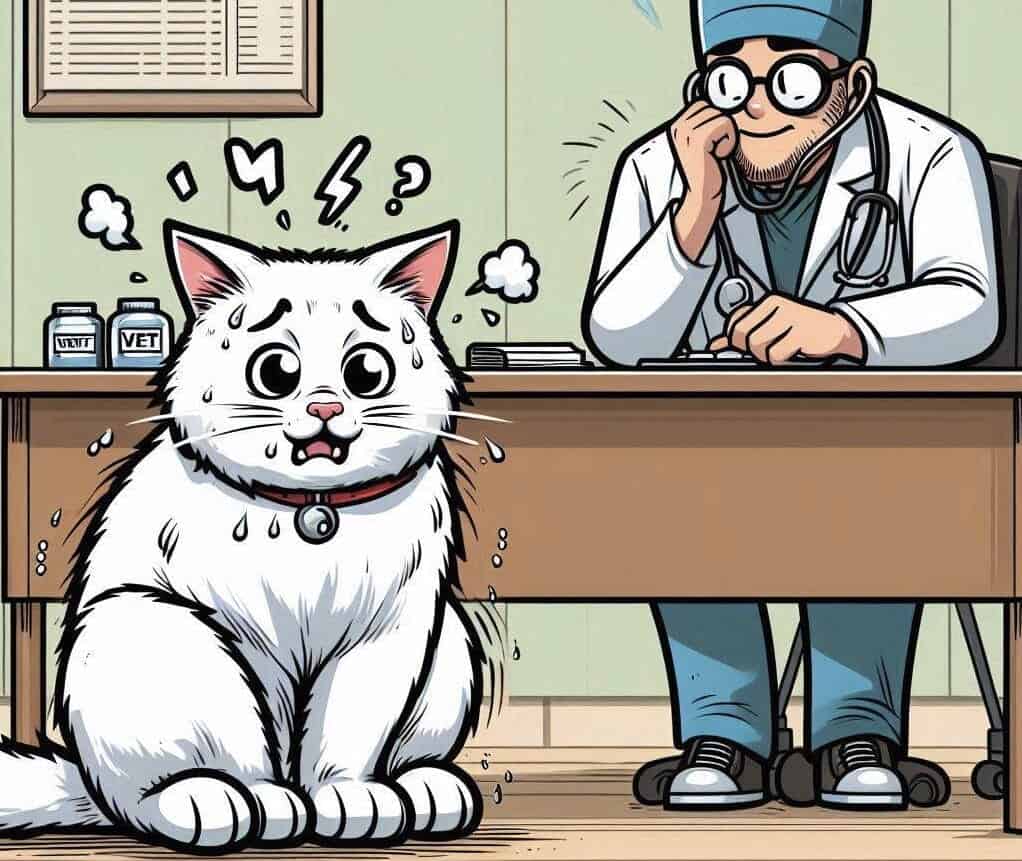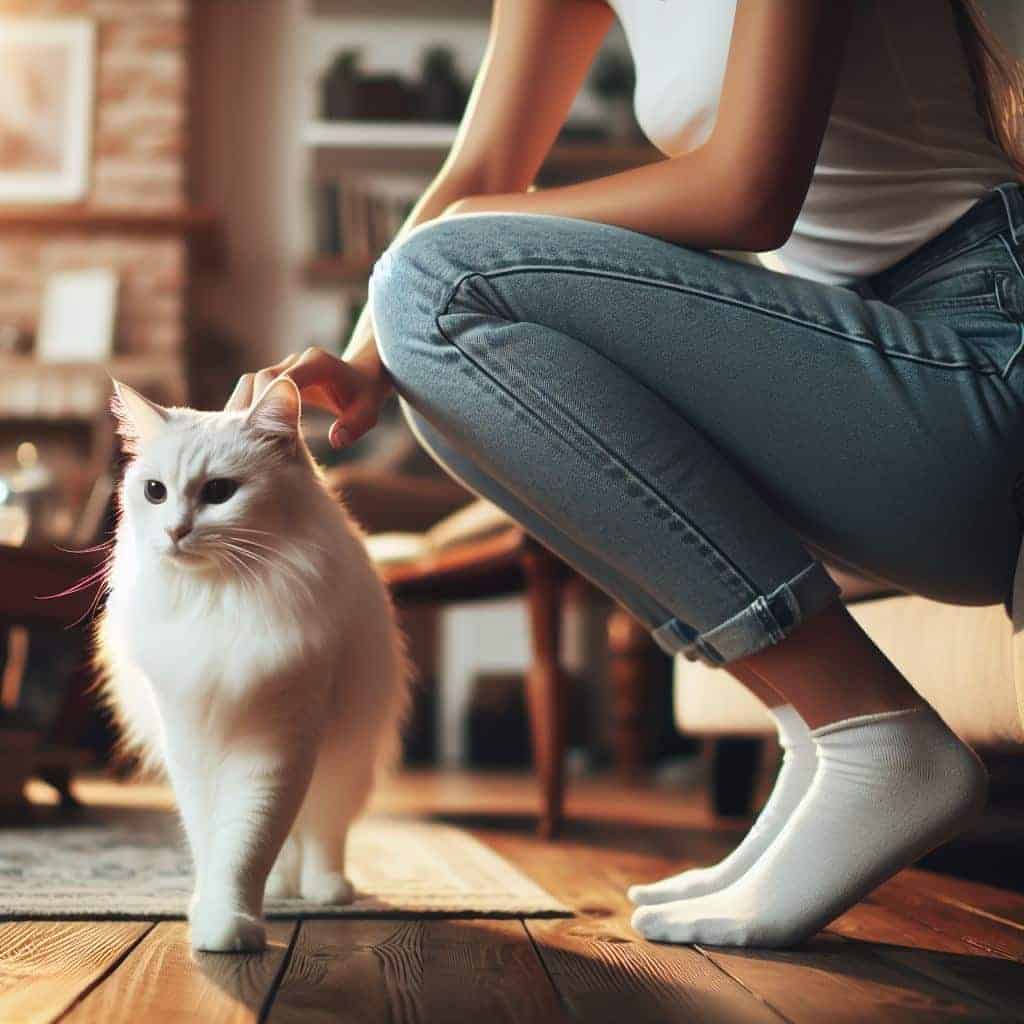Have you ever noticed your cat acting strangely, like hiding more often or grooming excessively? I experienced this with Doofy. At first, I thought it was just typical cat behavior. But after doing some research and taking Doofy to the vet, I learned that he was actually dealing with cat anxiety.
Why Cat Anxiety Matters
Cat anxiety is surprisingly common but often goes unnoticed. Many cat owners might mistake the signs of anxiety for simple personality traits. Knowing the symptoms and causes of cat anxiety can make a big difference in your pet’s life. By identifying these signs early on, we can offer prompt assistance and care.
What You’ll Learn
In this guide, I’ll explain:
- Common signs of anxiety in cats
- Causes behind those anxious behaviors
- Effective strategies to manage and reduce your cat’s anxiety
Are you ready to get started? Let’s help our furry friends live their best, stress-free lives!
For more information on other unusual cat behaviors:
- Recognizing whisker fatigue symptoms can help you better understand and care for your cat.
- Have you ever wondered why cats prefer running water? Discover the fascinating reasons behind their love for running water and how it connects to their natural instincts.
- If your cat sneezes frequently, it may be a sign of a problem. Here’s what you can do: Cat Sneezing Frequently? Here’s What To Do!
Recognizing the Signs of Anxiety in Cats
Understanding cat anxiety symptoms is crucial for any cat owner. Cats often exhibit subtle behavioral changes that can indicate heightened anxiety levels. Paying attention to these signals can help you address issues before they escalate.
Let’s dive into some common signs of anxiety in cats.

1. Inappropriate Elimination: When Peeing Outside the Litter Box Becomes a Cry for Help
Finding your cat urinating outside the litter box can be frustrating, but it might be more than just a nuisance. This behavior often serves as a cry for help from your feline friend. Cats may avoid their litter box due to stress or anxiety triggered by various factors such as:
- Changes in the household environment
- Introduction of new pets or family members
- Inconsistent cleaning of the litter box
It’s essential to rule out any medical conditions like urinary tract infections, which can also cause inappropriate elimination. Once medical issues are ruled out, consider environmental stressors and work on creating a calm and secure space for your cat.
2. Uncovering the Link Between Stress and Excessive Grooming Habits in Felines
Excessive grooming, known as psychogenic alopecia, is another telltale sign of anxiety in cats. While grooming is a natural and healthy behavior, overdoing it can indicate underlying stress. Look out for:
- Bald patches or thinning fur
- Constant licking or biting at specific areas
This behavior often stems from anxiety related to environmental changes or social stressors within the household. Providing mental stimulation through toys and interactive play can help alleviate some of this stress.
3. Understanding the Role of Aggression as a Defense Mechanism in Anxious Cats
Aggression in cats can manifest as a defense mechanism when they feel threatened or anxious. It’s important to recognize that this aggression is not about dominance but rather fear and self-preservation. Some signs include:
- Hissing, growling, or swatting
- Biting or scratching without apparent provocation
Addressing aggressive behaviors involves understanding the root causes and working on reducing triggers. Ensuring that your cat has safe spaces where they can retreat will help them feel more secure.
Recognizing these behaviors early allows you to take appropriate measures to help your feline friend cope with their anxiety. Each cat is unique, so what works for one might not work for another. Keeping an eye on these signs will give you invaluable insights into their emotional well-being.
Understanding these signs and seeking timely intervention not only improves your cat’s quality of life but also strengthens your bond with them.
Understanding the Underlying Causes
Recognizing the signs of anxiety in cats is one part of the puzzle. Understanding what triggers this anxiety is equally crucial. Cat anxiety can stem from various sources, some of which are quite different from human anxiety triggers.
Common Triggers for Anxiety Disorders in Cats
While we might worry about work deadlines or social interactions, our feline friends have their own unique set of stressors:
- Separation Anxiety: Unlike humans, cats often form strong bonds with their owners and may feel distressed when left alone. This can manifest as destructive behavior or excessive vocalization.
- Trauma: Past negative experiences can leave a lasting impact on a cat’s mental state. Traumas such as abuse, accidents, or even a rough trip to the vet can cause ongoing anxiety.
- Lack of Social/Environmental Exposure: Kittens that miss out on early socialization or are confined to limited environments may struggle with anxiety later in life. They might find new people, places, or pets incredibly stressful.
The Impact of Separation Anxiety on a Cat’s Overall Well-being
Separation anxiety is a relatively common issue among cats, especially those who have formed a strong attachment to their owners. Signs include:
- Destructive Behaviors: Scratching furniture or knocking over items when left alone.
- Excessive Vocalization: Meowing or crying persistently when you’re not around.
- Inappropriate Elimination: Urinating outside the litter box as a way to cope with stress.
These behaviors not only indicate distress but also affect the cat’s physical health and overall quality of life.
Investigating Past Traumas That May Haunt Your Feline Friend’s Present State of Mind
Trauma can be a significant underlying cause of anxiety in cats. Events that might seem minor to us can be deeply unsettling for them:
- Abuse or Neglect: Cats rescued from abusive situations often carry emotional scars that manifest as chronic anxiety.
- Accidents or Injuries: A painful injury or frightening accident can lead to long-term stress responses.
- Veterinary Visits: Traumatic experiences at the vet can make future visits highly stressful for your cat.
Understanding these past events is crucial for providing appropriate support and care.
The Importance of Early Socialization in Building Resilience Against Future Anxieties
Early socialization plays a vital role in shaping how a cat responds to its environment:
- Exposure to Various Experiences: Introducing kittens to different sights, sounds, people, and other animals helps them become more adaptable adults.
- Building Trust and Confidence: Positive interactions during kittenhood foster trust and confidence, reducing the likelihood of anxiety later on.
- Preventive Measures: Proper socialization up to 14 weeks old significantly reduces the chances of developing fearful behaviors.
For more insights into how environmental factors influence feline behavior, you might find this article enlightening. It delves into whether cats can sense fear and how they react to our emotional cues.
Exploring these underlying causes provides valuable context for why your cat might be experiencing anxiety. Identifying specific triggers allows you to take targeted steps towards alleviating their stress and improving their well-being.
Additionally, it’s important to understand other aspects of your cat’s health beyond anxiety. For instance, if you’re wondering about how cats regulate their body temperature during hot weather, this resource would be helpful.
Steps to Take in Helping an Anxious Cat
The Vital Role of Veterinary Care
Caring for an anxious cat often starts with a visit to the veterinarian. A vet’s expertise is crucial in diagnosing and treating feline anxiety disorders, offering a comprehensive understanding of your cat’s health and behavior.

Making That VERY First Vet Appointment
When preparing for your first vet appointment, consider these steps:
- Gather Information: Note down any unusual behaviors or symptoms you’ve observed. This can include details on your cat’s eating habits, litter box use, grooming activities, and social interactions.
- Prepare Your Cat: Use a calm voice and gentle handling when placing your cat in the carrier. You might want to introduce the carrier as a safe space beforehand by leaving it open in your home with some comfortable bedding inside.
- Expect a Thorough Examination: The vet will perform a comprehensive physical exam, including checking your cat’s weight, temperature, heart rate, and overall condition.
Remember, this appointment is not just about the physical check-up. It’s also about discussing behavioral concerns that might indicate anxiety.
Working Hand in Hand with Your Vet
After the initial examination, collaborating closely with your vet helps rule out any underlying medical conditions that could be contributing to anxiety. Common conditions like hyperthyroidism or dental disease can manifest as behavioral issues.
- Diagnostic Tests: Blood tests, urine analysis, and other diagnostic procedures may be recommended to check for illnesses that could affect your cat’s behavior.
- Behavioral History: Provide detailed information about any recent changes in your cat’s environment or routine that could be potential stressors.
This collaborative approach ensures that medical conditions are addressed alongside behavioral concerns.
Additional Tests and Assessments
To get a full picture of your cat’s anxiety, your vet might suggest further evaluations:
- Behavioral Consultations: These sessions involve observing your cat’s behavior in various scenarios to identify specific triggers.
- Video Analysis: Recording your cat during different activities can help pinpoint moments of stress or anxiety.
- Specialized Testing: In some cases, advanced imaging like X-rays or ultrasounds might be necessary to rule out less obvious health issues.
Understanding the root cause of anxiety is essential for effective treatment. By following these steps with your vet, you lay the groundwork for helping your feline friend lead a calmer and happier life.
Effective Strategies for Managing Cat Anxiety
1. Creating a Haven: The Role of Safe Spaces
Cats thrive in environments where they feel safe and secure. For an anxious cat, creating a dedicated safe space can be transformative. This is not just about providing a physical space but also about ensuring it meets their emotional needs.
How to Design and Set Up a Safe Space:
- Vertical Elements: Cats love to climb and perch. Tall cat trees, shelves, and window perches can provide your cat with vantage points that help them feel secure.
- Quiet Retreats: Choose a quiet area of your home where your cat can retreat without being disturbed. This could be a separate room or a secluded corner.
- Comfortable Bedding: Soft, comfortable bedding can make the space more inviting. Consider adding familiar items like your cat’s favorite blanket or toys.
- Environmental Enrichment: Incorporate elements that stimulate your cat’s senses positively. Interactive toys, scratching posts, and puzzle feeders can keep them engaged.
A well-designed safe space can make a significant difference in managing your cat’s anxiety. It provides them with a sanctuary where they can retreat when feeling overwhelmed.
Understanding Desensitization
Desensitization is a behavioral modification technique used to help cats gradually get accustomed to specific fears or anxieties. The idea is to expose your cat to the anxiety-inducing stimulus at a very low level that does not provoke fear, then slowly increase the exposure over time.
Steps to Implement Desensitization:
- Identify the Trigger: Determine what specific stimulus causes your cat’s anxiety. This could be anything from loud noises to new people in the house.
- Controlled Exposure: Start by exposing your cat to the trigger at a minimal intensity. For example, if your cat is afraid of loud noises, begin with very soft sounds.
- Gradual Increase: As your cat becomes comfortable with the low-level exposure, gradually increase the intensity or duration of the exposure.
- Positive Reinforcement: Pair the exposure with something positive like treats or playtime. This helps create positive associations with the previously feared stimulus.
Practical Steps for Desensitization Programs
Creating and executing a successful desensitization program requires patience and consistency.
Implementing Desensitization:
- Set Realistic Goals: Understand that desensitization takes time. Set small, achievable goals for each session.
- Consistency is Key: Regular sessions are crucial for success. Consistency helps reinforce positive associations.
- Monitor Stress Levels: Always watch for signs of stress during sessions. If your cat shows signs of fear or anxiety, reduce the intensity of exposure immediately.
- Celebrate Progress: Every small victory counts. Celebrate progress by rewarding your cat and noting improvements.
2. The Power of Positive Reinforcement: Using Counterconditioning Techniques
Creating a safe environment for anxious cats involves more than just physical spaces; it also requires behavioral modification techniques to help them manage their emotions. One such powerful technique is counterconditioning, which plays a crucial role in modifying negative associations that trigger anxiety in cats.
Exploring the Role of Counterconditioning
Counterconditioning is about changing a cat’s emotional response from negative to positive when faced with a specific stimulus. This method works by gradually associating the anxiety-inducing trigger with something positive, like treats or playtime. For instance, if your cat gets anxious around new people, you can start by offering treats whenever a new person enters the room. Over time, your cat will begin to associate the presence of strangers with positive experiences.
Key points to remember about counterconditioning:
- Consistency: Regularly use rewards in the presence of the anxiety trigger.
- Patience: It may take time for your cat to develop new associations.
- Observation: Monitor your cat’s reactions and adjust the process as needed.
2.1 Creating Positive Experiences through Rewards and Incentives
Understanding how to create positive experiences for your feline friend is essential. Here are practical steps to implement counterconditioning effectively:
- Identify Triggers: Determine what specifically causes anxiety in your cat. This could be anything from loud noises to unfamiliar environments.
- Controlled Exposure: Introduce the trigger at a low intensity that doesn’t provoke fear. Gradually increase exposure as your cat becomes more comfortable.
- Use High-Value Rewards: Treats, toys, and affection serve as powerful incentives. Ensure these rewards are highly valued by your cat.
- Pairing Stimulus with Reward: Whenever the anxiety-inducing stimulus is present, immediately follow it with a reward. For example, if your cat fears car rides, offer treats during short trips.
By implementing these steps, you can help shift your cat’s emotional response from fear to joy.
Practical Examples of Counterconditioning
To illustrate how counterconditioning can be applied:
- Fear of New People:
- When introducing someone new, have them stay at a distance while you offer treats or play with your cat.
- Gradually decrease the distance over multiple sessions until your cat becomes comfortable with the person’s presence.
- Anxiety Around Other Pets:
- Start by allowing brief glimpses of the other pet while rewarding calm behavior.
- Slowly increase their interaction time while maintaining positive reinforcement.
These examples show how creating a secure and stimulating surroundings can significantly impact an anxious cat’s well-being.
For more insights on understanding feline behaviors, check out our Pet Guide To Understanding Why Does My Cat Blink One Eye. Discovering such intricacies can deepen your bond with your furry companion.
Additionally, it’s important to consider your cat’s diet when addressing their anxiety. While we focus on behavioral techniques here, it’s worth noting that certain foods can also affect their well-being. For instance, have you ever wondered whether cats can eat pizza crust? Exploring feline nutrition can provide valuable insights into their dietary needs and help you make informed decisions about treats and food choices.
3. Exploring Alternative Avenues: Calming Aids and Medication Options
Creating a safe environment for anxious cats involves more than just behavioral modification techniques. Sometimes, supplementing these strategies with calming aids and medications is necessary to help your feline friend find peace.
Understanding the Different Types of Calming Pheromones
Calming pheromones can be instrumental in creating a sense of security for your cat. These synthetic versions of natural feline facial pheromones mimic the comforting signals that cats use to mark their territory as safe.
- Feliway: A popular option, Feliway diffusers and sprays are designed to reduce stress-related behaviors like urine marking and excessive scratching.
- Comfort Zone: Another effective brand, offering similar benefits in reducing anxiety and promoting relaxation.
These products can be particularly beneficial when introducing changes in the household or when traveling with your cat.
Examining the Potential Benefits and Risks of Using CBD Products
CBD products for cats have gained popularity as a potential tool for anxiety management. Derived from hemp, CBD oil is believed to interact with the endocannabinoid system, which plays a role in regulating mood and anxiety.
- Benefits: Anecdotal evidence suggests CBD may help reduce anxiety, improve appetite, and promote overall calmness.
- Risks: It’s essential to consult with your vet before using CBD products. Not all CBD oils are created equal, and dosage can be tricky. The lack of extensive scientific research means potential long-term effects are still unknown.
Exploring Natural Supplements That Have Shown Promise
Natural supplements offer another avenue for managing feline anxiety. Some options include:
- L-Theanine: An amino acid found in green tea, known for its calming effects.
- Bach Flower Remedies: Specifically, Rescue Remedy is formulated to relieve stress in pets.
- Valerian Root: Often used in herbal medicine for its sedative properties.
These supplements can be used alongside behavioral modification techniques to provide comprehensive support.
When to Consider Anti-Anxiety Medication
In some cases, natural remedies and behavioral strategies might not be enough. Anti-anxiety medication could then become a viable option. Common pharmaceuticals include:
- Gabapentin: Originally an anti-seizure medication, it’s also effective in reducing anxiety in cats.
- Buspirone: Primarily used as an anti-anxiety drug, it helps by altering serotonin levels to promote calmness.
Your vet will consider the severity of your cat’s anxiety and any underlying health conditions before prescribing these medications. Regular monitoring and follow-up appointments ensure that the treatment is effective without adverse side effects.
Creating a secure and stimulating environment is crucial for cats battling anxiety issues. Combining this with appropriate calming aids or medications can significantly improve their quality of life.
Understanding how to address your cat’s unique needs requires patience and a multi-faceted approach. Behavioral modification techniques such as desensitization—controlled exposure to stimulus at low levels—should work hand-in-hand with these supplementary aids for the best results.
Prevention Strategies for Long-Term Wellness
To help cats develop resilience and emotional well-being, it’s important to start implementing preventive strategies as early as possible. This will make it easier to keep anxiety at bay.
Socialization of Kittens
Proper socialization is crucial for ensuring that cats grow up to be well-adjusted. When kittens are exposed to different people, environments, and experiences between the ages of 2-14 weeks, they tend to be more adaptable and less likely to develop anxiety later on.
Here are some tips for socializing kittens:
- Introduce New Experiences Gradually: Start with short and positive experiences, using treats and gentle encouragement to create a positive association.
- Expose Them to a Variety of People: Make sure your kittens interact with different types of people, including children and elderly individuals. This guide on kitten socialization can provide further assistance.
- Allow Exploration of Different Environments: Supervise your kittens as they explore various areas of your home, helping them feel comfortable in different spaces.
Creating a Stable Environment
Having a consistent and secure environment can greatly reduce stress levels in cats and promote emotional stability. Here’s what you can do:
- Maintain Routines: Stick to regular feeding times, play sessions, and bedtime routines. This helps cats feel secure and know what to expect.
- Provide Safe Spaces: Designate quiet areas in your home where cats can retreat to when they feel overwhelmed or need some alone time.
Positive Reinforcement
Using positive reinforcement techniques can reinforce good behaviors in cats and boost their confidence. Here’s how you can incorporate positive reinforcement into your cat’s routine:
- Reward Calm Behavior: Whenever your cat displays calm behavior in new or potentially stressful situations, give them treats, gentle petting, or verbal praise.
- Engage in Playtime: Regular play sessions with interactive toys like feather wands or laser pointers not only provide physical exercise but also help reduce anxiety levels in cats.
Medication for Anxious Cats
In some cases, despite implementing preventive measures, cats may still exhibit severe anxiety. If this is the case, consult with a veterinarian who may recommend medications such as Gabapentin to alleviate their symptoms.
By investing time in these preventive measures and seeking appropriate guidance when needed, you set the foundation for a happier and healthier feline friend.
My Thoughts
Supporting cats through their anxiety journey involves understanding cat anxiety symptoms and treatment. My own experience has shown that recognizing the signs early and providing appropriate treatment and management for cat anxiety can make a significant difference in your furry friend’s well-being.
Remember, patience and consistency are key. Your efforts to understand and support your anxious cat will lead to a happier, healthier life for both of you.

In her previous life, Lisa traveled extensively, both for work and leisure. After the pandemic struck, Lisa locked up her luggage and adopted a cat ever since.
Lisa is now an avid cat lover, she devotes most of her free time serving as butler to her adorable feline at home. When she is not with her cat, she can be seen using her phone sourcing for the latest cat supplies online.


